C1, Metropolitan Wharf, Wapping Wall, London, E1
What's cooler than being cool? Ice cold! Obviously. What did it take to be cool in the 1990s? Shades. Check. A leather jacket. Check. White shirt. Check. Jeans. Check. Helicopter (optional). Check. No one was cooler than the Bitmap Brothers.Initially there were three Bitmap Brothers; Mike Montgomery, Eric Matthews and Steve Kelly. Mike Montgomery taught himself machine code on the ZX81 and moved up to the Spectrum. He got a job at Leisure Genius and worked on titles like Monopoly and Scrabble. Steve Kelly programmed for Sinclair and is credited on Match Point, Scrabble (a different version to Mike Montgomery's version), and Chequered Flag. Eric Matthews' first credit is the Atari ST version of Karate by Eidersoft which was programmed by Steve Kelly. And, according to ACE magazine Mike met Eric at Virgin (presumably after Virgin Games takeover of Leisure Genius around 1987). Thus the triangle was complete.
According to ACE, "Eric was responsible for for coming up with the idea of Xenon [the Bitmap Brothers first game], but initially they had trouble selling it because Gridrunner had just come out on the [Atari] ST and nobody wanted scrolling shoot-em-ups." (November 1988, page 9). Although Xenon appeared under the Melbourne House name the struggling company was acquired by Mastertronic in 1987, and by the time the Commodore 64 and Spectrum versions of Xenon appeared in 1989 Mastertronic itself had been taken over by Virgin Games.
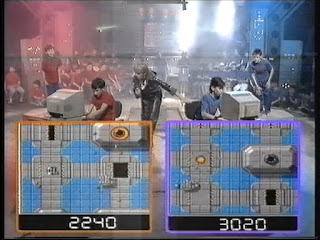 |
| Get Mucky segment from Get Fresh 6th August 1988 |
Xenon got a huge boost when it featured on ITV's Saturday morning children's show Get Fresh, in a segment called Get Mucky. Two teams would play a specially modified version of the game where getting hit reduced your points instead of draining your fuel and killing you. The first two rounds were played on level one and the final on level three. The loser got gunged, hence the Get Mucky name. Mike Montgomery later told redbull.com: "I did some work for a guy who used a Commodore Amiga to do a game show on TV... I did this for free, and whilst he was in a meeting with the producers of Get Fresh, the idea of playing a video game on TV was discussed. Needless to say, he returned the favour." Mike talked about the Get Fresh version to AMIGA COMPUTING in 1988: "Unfortunately all the games were recorded in a two day stint and the kids realised that if they flew slowly they would avoid the big enemy at the end which would rob you of all the points you had won in the last few seconds. A poor but sly player could beat a brave but skilful one." (December 1988 page 78)
Mirrorsoft announced their spinoff label Image Works in the summer of 1988, and the Bitmap Brothers signed up. Xenon had been released at the start of 1988 and it's a mark of how quickly the game built the Bitmap Brothers reputation that their signing was seen as a big part of the news. Stories listed the Bitmaps as peers of Graftgold, Denton Designs, and name programmers like Tony Crowther, Jon Ritman, and Jeff Minter. COMMODORE USER described their signing as a "major coup." And, it seems like every magazine that reported the news printed a picture of the Bitmap Brothers standing in front of a helicopter.
It's late eighties aspiration in a photo. Here were the successors to the boy wonder programmers of Imagine posing in front of the results of their fame and fortune. Except... Image Works' PR Manager Cathy Campos told RETRO GAMER, "we did that photo shoot of the Bitmaps in front of Robert Maxwell’s helicopter." You can make out the Mirror Group Newspaper lion logo behind Mike and Eric. Mike Montgomery later told redbull.com, "We never did meet Robert Maxwell... the day we got permission to use his helicopter for the photo-shoot was a nightmare, as we had only twenty minutes to do it before it was wrapped up and we had no idea what time this would be. Robert was at an Epsom race horse meeting that day, so we had to wait with our photographer from about midday until he landed on the top floor of the Maxwell building. It was a stroke of luck that he landed just as the sun went down, which of course made the pictures even better." The pictures went out to magazines desperate for visual material to illustrate dry news stories, and as Domark found, if you gave the magazines a decent photograph they'd use it. Again and again and again.
Image Works got four titles out of the Bitmap Brothers; Speedball (1988), Xenon II: Megablast (1989), Cadaver (1990), and Speedball 2: Brutal Deluxe (1990). Then, just as quickly as the Bitmaps joined Image Works they left. The One magazine reviewed Speedball 2 in October 1990 and in same issue revealed details about Renegade, their new publisher. Renegade was established by The Bitmap Brothers plus Martin Heath and Adele Nozedar of Rhythm King Records, and Tom Watson formerly of Telecomsoft and Mirrorsoft. It would give a better deal to developers, splitting revenue evenly between publisher and developer, "after expenses have been deducted," as THE ONE noted (October 1990 page 13). "Renegade hopes to shake up what it sees as the software industry's indifference to programmers by concentrating on the personalities behind the games in the same way that record sleeves feature the artist's name rather than the publishing company's." But:
"one software publisher, who chose to remain nameless, scoffed at Renegade's proposed pay deals and promotion of the programmer, saying: "This isn't the record business, and these people are very naive to think that they can just come in and change things around just like that."
"Apart entirely from the fact that there are numerous hidden costs and expenses that have to be incurred by the publisher to make this kind of deal almost impossible to implement, computer software is different to pop music in that any given program is usually the product of far more people than just the programmer - so why should he get all the credit?"
I thought the Bitmap Brothers founded Renegade after the collapse of Mirrorsoft but that's not the case. Gods and Magic Pockets both came out on the Renegade label in 1991, well before the death of Robert Maxwell took down his business empire. Renegade then picked up Fire & Ice from Graftgold, which was originally developed for Mirrorsoft/Image Works. Sensible Software also moved over to Renegade although they continued to work with other companies because as Sensible's Chris Yates told THE ONE: "The major reason behind not putting all out games with one publisher is so that, if one company goes down, we don't immediately lose 80% of our business. If anything, that's what we learned from Mirrorsoft." THE ONE AMIGA (November 1992 page 42). Renegade remained the home of the Bitmap Brothers until 1996 and the release of Z. Time Warner had acquired the publisher in 1995 and the Bitmaps only moved only moved on when the brand ceased to exist, following the sale of Warner Interactive Entertainment Ltd to GT Interactive in November 1996.
It's not clear what happened after the release of Z. There's a gap of four years until the release of a PlayStation version of Speedball in 2000, called Speedball 2100. Mobygames notes that: "In 1998, Kelly and Matthews both stepped down from the board to concentrate on games design and programming respectively," and goes on to add, "Mike Montgomery took on the role of Managing Director and successfully drove the company forward, investing in personnel and equipment that enabled the company to develop a new range of next-generation games software. Employing over 20 designers, programmers and artists, the Bitmap Brothers remained fiercely independent and entirely privately owned." Which reads like something copied from a press release. I've noted before (at the bottom of the Hewson article) that it gets harder to track companies through the nineties and into the early years of the millennium. This is the period when Future Publishing become the dominant force in computer magazines and they don't want digital copies of their magazines archived. They are absolutely entitled to protect their copyright but by god it's irritating when they do and entire runs of magazines, like AMIGA POWER, disappear from the internet. But I digress. The Bitmap Brothers continued on into the 2000s. At one point they opened an office in Harrogate, which I don't stand a chance of locating. If you know it, drop an email to whereweretheynow@gmail.com
Z: Steel Soldiers arrived in 2001, then World War II: Frontline Command in 2003, and a couple of PC conversions for Namco; kill.switch and Pac-Man World 2. The last four titles listed on the Bitmap's Mobygames page are Ford Racing: Full Blown (2006), Speedball 2: Tournament (2007), Speedball 2 HD (2013), and The Bitmap Brothers Collection 1 (2021) but it's not clear how much involvement The Bitmap Brothers actually had with any of these projects; and the presence of Ford Racing: Full Blown on the Mobygames list is especially odd. Rebellion acquired The Bitmap Brothers brand and games in 2019. They don't seem to have done anything with the IP as yet but you can buy a lovely selection of t-shirts; appropriate for a company who were a label as much as they were a developer,
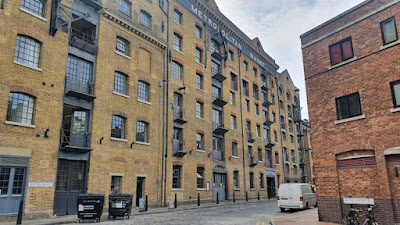 |
| October 2022 |
Wapping is like an island. Cut off from London on one side by the Thames and on the other by the four-lane A203. The traffic noise fades as you walk down Garnett Street and cross an old swing bridge which passes over the cut between Shadwell basin and the eastern dock of London Dock. I was there on a weekday morning and the whole area was quiet and felt very unlike London. Metropolitan Wharf is a huge yellow brick warehouse where the Bitmap Brothers address of C1 places them, presumably, on the third floor. The main entrance to Metropolitan Wharf is just to the left of the white van in the picture. I didn't go in. There was a glass screen and serious looking people hanging around, and I regret to report this otherwise fearless reported suffered a failure of nerve and didn't take up the offer of the sign to the left of the door which reads "riverside view available to general public upon request." I was tempted by the Prospect of Whitby (London's oldest riverside pub) but instead I went down to the Thames to see if I could get a riverside view by other means. I found a narrow alleyway around the corner, at the curve into Wapping High Street, and wandered down it to find a metal gate and a set of steps.
This is New Crane stairs. New being used in the British sense of the word which means they can be dated back to maps made in 1682. Luckily I'd arrived at low tide and I was able to walk down onto the Thames foreshore. A quick walk round the corner and I had a view of the Metropolitan Wharf terrace, where no doubt the programmers relaxed and took in the sights and smells of the Thames while sipping trendy cocktails and waiting for the 3pm helicopter.
 |
| October 2022 |
Do you know why Ford Racing: Full Blown is listed on the Bitmap Brothers' Mobygames page? Leave a comment or email whereweretheynow@gmail.com or follow me on Twitter @ShamMountebank where, in an exciting development, I now have a huge 30 followers.
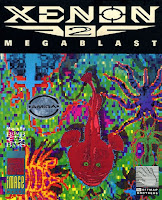



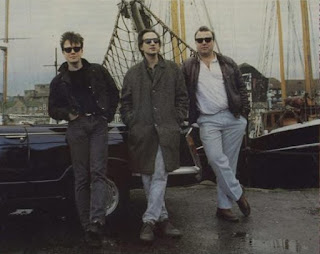
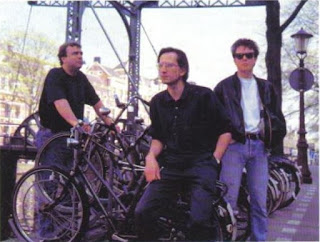
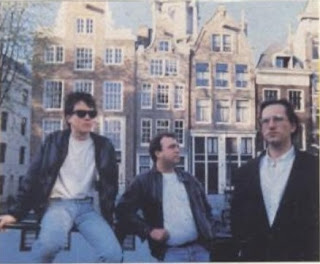









No comments:
Post a Comment